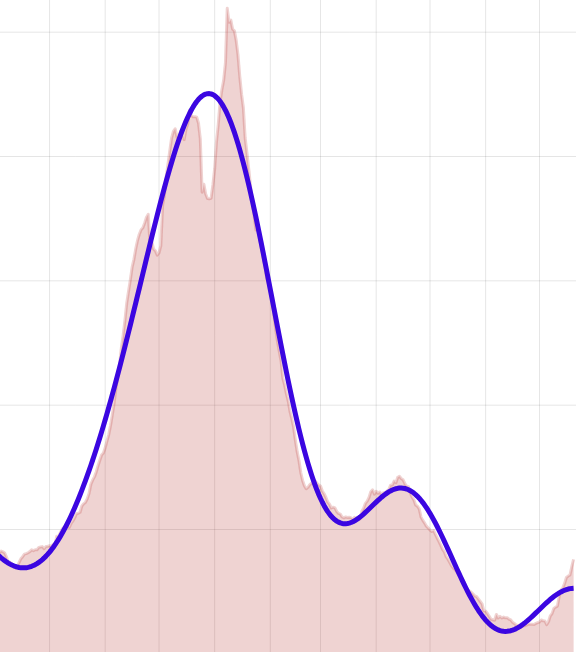0.203188
by Brian Hayes
Published 28 February 2006
In a “Computing Science” column titled “Rumours and Errours,” not quite a year ago, a leading role went to the nondescript number 0.203188. That number emerged from a simulation of how rumors spread through a society; given certain assumptions, 0.203188 is the proportion of the population that never hears the rumor.
A few weeks ago Paul Krapivsky of Boston University wrote me to say that the number mentioned in the column looked familiar, and he directed me to two other papers in which it appears:
Chang, Joseph T. 1999. Recent common ancestors of all present-day individuals. With commentary. Advances in Applied Probability 31:1002–1038.
Derrida, Bernard, Susanna C. Manrubia and Damián H. Zanette 1999. Statistical properties of genealogical trees. Physical Review Letters 82:1987–1990.
Both of those articles take up questions of human ancestry and genealogy, a topic that might seem remote from rumor-mongering, but in fact the conceptual connection is close. The starting point for both discussions of genealogical trees is an extraordinary all-or-nothing observation: If you look back just a few dozen generations in human history, it’s a reasonable approximation to say that anyone who was alive then is either an ancestor of everyone alive now or else is an ancestor of no one living today—the lineage went extinct. And the probability of extinction for human families is the same curious number encountered in rumor studies; Chang gives the value as 0. 20319, whereas Derrida, Manrubia and Zanette supply a few more decimal places—0.20318787. (Derrida, Manrubia and Zanette have also presented this work in American Scientist, but in that article they just miss mentioning the number.)
Krapivsky adds that it’s not altogether suprising for a number like 0.203188 to turn up in diverse contexts, because it derives from a fairly simple mathematical process. The number can be defined as the fixed point of the equation
 .
.
What’s a fixed point? Suppose you make an initial guess about the value of S, such as S=0.5. Plugging this estimate into the righthand side of the equation yields a new approximation of S equal to e–1, or 0.367879. Inserting the newly calculated value into the righthand side produces a third estimate, 0.282454. If you keep going in this way, you’ll converge on a fixed point: 0.20318787…. (Strictly speaking, the process never quite gets to the fixed point, but the “…” notation means that we don’t even know where the fixed point is, exactly, so this is understandable. Also note that the initial guess needs to be less than 1.)
For purposes of describing rumors and family trees, having five or six digits of this number is more than enough precision, but when you look at it as a mathematical constant, there’s no reason not to calculate some more decimal places. It’s not hard to do that with the iterative scheme described above. If you perform this operation with the kind of floating-point arithmetic common in many computers and programming languages, the most you can hope to get is about 16 decimal digits. The value I came up with in this way is 0.2031878699799799. What a suspicious-looking number! Could the pattern continue? Of course not; the 699799799 sequence here is no more meaningful than the 18281828 found among the early decimal digits of e. Here are some more digits, for your reading pleasure:
0.203187869979979953838479062062419879105498787590570 3175002477441519575075919060248836250361690779642914 691870155025100376806318211969115434998991230687792 8607856089683113536220973669731670519088210949
Since this number appears in the literature of rumor-propagation and in studies of theoretical genealogy, there’s every reason to expect that it might be found elsewhere as well. I tried typing some digits into Simon Plouffe’s Inverse Symbolic Calculator, now known as Plouffe’s Inverter, but it appears that fixed points of exponential equations are not among the 215,000,000 numbers in Plouffe’s database. The number can be found, as a sequence of decimal digits, in Neil J. A. Sloane’s marvelous Online Encyclopedia of Integer Sequences, but it was put there (by one Robert G. Wilson v) following the publication of “Rumours and Errours,” and so I learned nothing new by looking it up.
Where to turn? Google, of course. A Google search for the first five or six digits yields many hits but nothing of interest. The documents found in this way are chock-full of numbers—coordinates, dimensions, measurements, statistics, timings, coefficients—but they are all just numeric underbrush. Appending another digit or two to the search string thinned out the background and revealed a preprint by Derrida, Manrubia and Zanette, with more on the family tree of mankind. Finally, searching for 0.2031878699 took me to a 2004 dissertation in engineering by Corine Marchand, who was evidently then a doctoral candidate at the Institut National Polytechnique de Grenoble, in France. The subject is detecting failures in communication networks; if I understand correctly (after reading only a small part of the dissertation), 0.2031878699 is the probability, given certain parameter values, that a “heartbeat” signal fails to reach a node of the network.
An interesting number, is it not? But there are a lot more where that one came from.
Publication history
First publication: 28 February 2006
Converted to Eleventy framework: 22 April 2025



